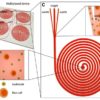Circulating tumor cells (CTCs) are tumor cells that are shed from cancerous tumors into the circulatory systems. CTCs are present in early-stage cancers and are reported to relate to disease prognosis. In recent years, CTCs have drawn increasing attention in both academic and industrial research, as they offer opportunities for the early detection, monitoring, treatment evaluation of cancer and its metastasis1.
CTCs are challenging to capture, isolate and characterize in nature. First, CTCs are extremely rare in patients’ blood samples. One CTC usually exists among a background of millions of blood cells. Furthermore, CTCs are highly heterogeneous in physical characteristics and biological properties. No separation technology which is based on a single capture mechanism can produce pure and representative CTC subpopulations. In the traditional liquid biopsy, CTCs are isolated either by immunoaffinity strategies or by biophysical features differentiation. However, existing macro-scale isolation systems suffer important drawbacks, such as low capture efficiency, incomplete automation and low viability of captured CTCs2. As a promising alternative, microfluidic technologies have gained tremendous interest in the field. Microfluidic technologies create devices that are at or smaller than the cellular length scale and enable accurate capturing and manipulation at single cell level. These technologies also offer precise control of fluid flow, which can greatly facilitate affinity reactions and physical separation. Moreover, on a microfluidic chip, CTC capturing and next-step analysis can be integrated to minimize intermediate sample handling and shorten the processing time. Above all, microfluidic approaches allow gentle isolation of live cells and thus enable many downstream analyses that rely on captured live CTCs3.
Microfluidic devices apply a wide range of principles for CTC isolations, including those that have been widely used in macro-scale systems such as magnetic-based separation, affinity chromatography and density gradient centrifugation, and novel mechanisms such as microfiltration in 2D and 3D by size and deformability4, inertial focusing, electrophoresis, and acoustophoresis. The performance of each isolation strategy is usually assessed by three figures of merits: capture efficiency(how many CTCs captured out of the total number of CTCs), capture purity (the ratio of captured CTCs to background contaminating cells) and throughput (how quickly a device can process a sample). Microfluidic devices have reported greater than 90% efficiency and purity, and throughput higher than 7.5 mL/hr1. However, there are always trade-offs among these three metrics. Due to the substantial heterogeneity in CTCs, no single isolation principle fits all applications. Combining two or more strategies are required to achieve high efficiency, purity, and throughput.

At the University of California, Los Angeles, Dino Di Carlo, Ph.D., and colleagues have developed High-Throughput Vortex Chip (Vortex-HT) technology, which uses parallel microfluidic vortex chambers to accumulate the larger circulating tumor cells from flowing blood. Vortex-HT reportedly generates less contamination with white blood cells than other technologies and isolates cells in a smaller output volume. Source: GEN
Despite the massive surge of innovation and research development in microfluidic CTC isolation devices in recent years, only a few of them have successfully undergone commercialization and been pushing towards clinical uses. Microfluidics-based CTC isolation systems face several major barriers to commercialization. To begin with, many microfluidic devices operate with complex peripheral fluidic components, such as pumps, pneumatic systems, connectors, and tubing. Their interfaces are usually not user-friendly. How to integrate the fluidic systems and simplify the user interface is the first step to an easy-to-use product5. Next, similar to other types of microfluidic systems, many published microfluidic CTC devices suffer from short lifespans due to material degradation, clotting, and fouling problems6. The associated device reliability and robustness issues also pose major challenges for commercialization. Last but not least, many microfluidic devices cannot produce high throughput, due to the miniaturized length scales. The ability of processing 7.5 mL of blood samples within a short time is required for CTC clinical applications. Yet few microfluidics-based systems are able to meet this requirement. For these reasons, the advancement of microfluidics-based CTC technologies should focus on developing efficient integration and user-friendly interface, enhancing reliability and robustness, and improving sample throughput as wells as capture efficiency and purity.
The author here shares multiple perspectives on opportunities and challenges of microfluidic technologies for circulating tumor cell analysis. Microfluidics-based CTC technologies have arisen rapidly as promising alternatives to traditional macro-scale CTC isolation and analysis systems. We have discussed the advantages of microfluidics-enabled platforms, current separation principles, and the barriers to successful commercialization. For future development, it is essential to recognize the substantial heterogeneity in CTCs’ characteristics. Isolation strategies should be designed with regard to different cancer types and even sub-types. It is also important to develop performance profiles (efficiency, purity, throughput, viability and etc.) based on cancer types that can allow researchers and clinic users to evaluate and compare different technologies1. Furthermore, research development and commercialization should continue exploiting the integration advantages of microfluidics systems. As current CTC research focus shifts from enumeration to characterization, integrated microfluidics systems that not only isolate cells but also perform downstream analysis can provide valuable information about cancer progress and metastasis. In addition, these integrated systems can potentially reduce assay cost significantly. It is worth noting that microfluidics systems need to overcome the aforementioned short life spans, reliability and robustness issues. For integrated systems, these issues will become even larger challenges to commercialization. Finally, it is surprising that a macro-scale immunoaffinity system developed by CellResearch remains the only FDA-approved CTC assessment platform since 2004.No other systems or microfluidic devices have been approved by FDA since then. Considering regulatory approvals, the field of microfluidic CTC technologies should drive more clinical relevant tests to increase the number of applications in clinical use and the impact in the medical industry2. We look forward to seeing the first and more microfluidics-enabled CTC platforms to obtain FDA approval in the next few years.
1. Ferreira, M. M., Ramani, V. C. & Jeffrey, S. S. Circulating tumor cell technologies. Mol Oncol 10, 374–394 (2016)
2. Li, P., Stratton, Z. S., Dao, M., Ritz, J. & Huang, T. J. Probing circulating tumor cells in microfluidics. Lab on a Chip 13, 602 (2013)
3. Dong, Y. et al. Microfluidics and Circulating Tumor Cells. J Mol Diagn 15, 149–157 (2012)
4. Au, S. H. et al. Microfluidic isolation of circulating tumor cell clusters by size and asymmetry. Scientific Reports 7, (2017)
5. Shields, C. W., Ohiri, K. A., Szott, L. M. & López, G. P. Translating microfluidics: Cell separation technologies and their barriers to commercialization. Cytometry Part B – Clinical Cytometry 92, 115–125 (2017)
6. Wyatt Shields IV, C., Reyes, C. D. & López, G. P. Microfluidic cell sorting: a review of the advances in the separation of cells from debulking to rare cell isolation. Lab Chip 15, 1230–1249 (2015)
Enjoyed this article? Don’t forget to share.

Yatian Qu
Dr. Yatian Qu is a microfluidics research scientist at Purigen Biosystems. She is working on developing hands-free solutions for extracting and quantifying nucleic acids from biological samples. She received her M.S. (2012) and Ph.D. (2016) in Mechanical Engineering from Stanford University. She has diverse research experiences in microfluidics, including developing novel electrophoresis techniques to extract nucleic acids and proteins from biological samples and developing high-performance water desalination systems using porous carbon materials. She is also the co-founder of Bay Area Microfluidics Network, an organization that brings together leaders in microfluidics to foster innovation and collaboration in Silicon Valley.




